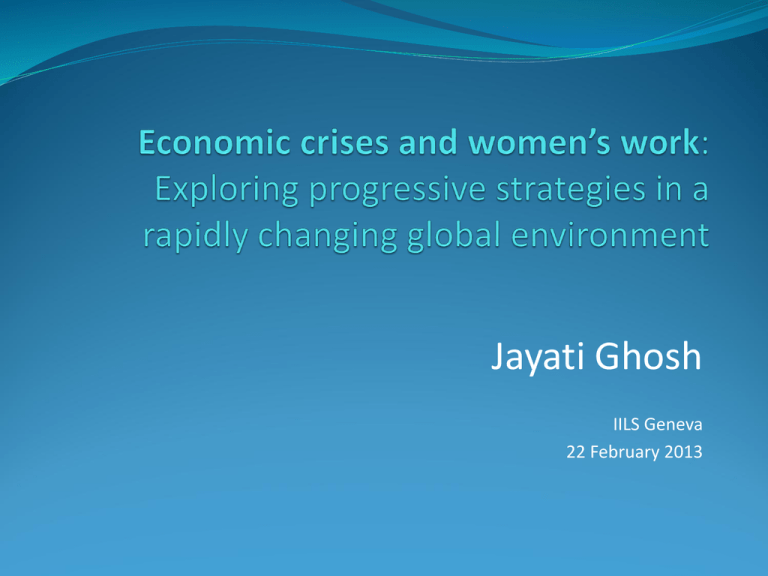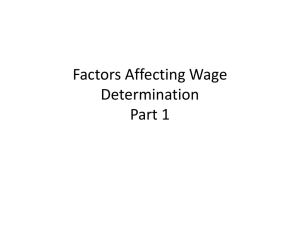
Jayati Ghosh
IILS Geneva
22 February 2013
Do crises affect men and women workers differently?
Different perspectives:
Women more prone to job loss because of
informal/casual /flexible contracts and involvement in
export activity.
Women less affected than men because service activities
less hit at least at first.
Women workers preferred because of lower reservation
wages and willingness to accept informal contracts.
In addition to paid workers, need to note
Self employed, especially in agriculture
Home-based activities
Migrant women workers
Unpaid labour
Factors affecting transmission of crisis
Significance of exports to economies with decelerating income
growth
Dependence on exports of products with high income elasticities
Export/import dependence on exports of primary commodities
with volatile prices (food and fuel)
Dependence on remittances from migrant workers and other
invisible earnings (tourism, other services) as well as the
gendered nature of the migration
Significance of foreign direct investment, portfolio flows and
cross-border bank lending (along with foreign aid) for balance of
payments financing
Demographic structures
Constraints on domestic space for countercyclical policies, such
as high current account deficit, high share of essential imports,
high government deficit or low level of external reserves
Perceptions of government debt sustainability that affect
countercyclical policies.
Change in unemployment rates by sex
% change over previous year
2.5
2
1.5
1
0.5
0
-0.5
-1
-1.5
Developed countries Men
Developed countries Women
Developing countries Men
Developing countries Women
Change in employment rates by sex
% change over previous year
5.0
4.0
3.0
2.0
1.0
0.0
-1.0
-2.0
-3.0
-4.0
Developed country Men
Developed country Women
Developing country Men
Developing country Women
OECD labour markets in current crisis
Labour force participation rates
(OECD average)
85.0
80.0
79.5
79.2
78.9
78.8
78.8
79.0
79.3
79.4
79.6
79.1
78.9
75.0
70.0
Female
65.0
60.9
61.0
61.5
61.8
62.3
62.9
63.5
63.8
64.3
64.6
64.9
60.0
55.0
50.0
2000
2001
2002
2003
2004
2005
2006
2007
2008
2009
2010
Male
Gendered crisis response in the eurozone crisis
Average of labour force
participation rates
Part time work as per cent of all
work
(Greece, Ireland, Portugal, Spain)
30.0
85.0
80.0
80.7 80.7 80.7
79.8 80.3
79.8
79.4
79.2
79.2
79.1 78.8
25.0
75.0
20.0
GIPS Average Female
70.0
Female
65.0
60.6
61.6
62.4 62.9
63.5
64.2
OECD Average
Female
15.0
GIPS Average Male
Male
10.0
OECD Average Male
59.3
60.0
56.9
58.1
55.7 55.5
5.0
55.0
2010
2009
2008
2007
2006
2005
2004
2003
2002
2001
2000 2001 2002 2003 2004 2005 2006 2007 2008 2009 2010
2000
0.0
50.0
Gender wage gaps in eurozone
Greece
Ireland
Portugal
Spain
Germany
Austria
France
Sweden
OECD average
2004
14.2
18.2
13.3
12.7
25.4
22.4
9.7
15.3
17.1
2005
16.5
13.8
16
12.5
23.1
22
12.1
14.4
16.7
2006
12.2
14.4
14
10.4
23.9
21.9
11.9
14.6
15.8
2007
12.2
18
15.5
8.8
22.8
21.6
12
16.4
16.3
2008
9.6
15
15.6
11.8
24
20.9
13.1
15.4
16.4
2009
9.6
10.4
15.6
11.8
21.6
19.4
13.1
14.9
15.9
Lessons from current and past crises
Initial impact of crisis is only the start – thereafter some
policy responses may make matters worse, both in
macroeconomic terms and for women workers.
Combination of fiscal austerity, deleveraging of private
debtors and pressure on wages can create or perpetuate
economic slump
So recovery need not occur even when “competitiveness”
improves through lower real wages.
Public spending and employment programmes, active
labour market and social protection are not just welfare
measures: they are important countercyclical buffers that
reduce or prevent downturns and enable faster recovery
Two phases of fiscal responses after 2008 crisis
Expansion phase 2009:
Increasing spending on infrastructure
Offering subsidies and tax reductions to stimulate labour
demand;
Expanding public employment, training programmes and
active labour market policies;
Increasing benefits for unemployed persons and elderly and
social assistance programmes to provide income support.
Contraction phase 2010-12:
Reducing public expenditure
Cutting or capping public sector wage bill
Reducing or removing food and fuel subsidies
Targeting or rationalising social safety nets
Reducing pensions
Gender perspective often missing in both phases
Focus on some types of infrastructure spending (e.g. China)
rather than on public spending that affects social reproduction,
unpaid labour and conditions of women.
Male breadwinner models implicit in much public spending,
including on social protection
Cash transfers with conditions that impose unpaid labour
requirements on women
Inadequate sensitivity to women’s concerns in labour markets
Little attention to informal work, including in agriculture and
special problems of women workers in such work
Gendered behaviour of credit markets not addressed
Inadequate attention to women migrant workers
Reduction in public spending on nutrition, sanitation, health
and education that affect women and girls disproportionately.
Can crisis response be gender-sensitive?
Gender-specific initiatives will not work if they are
afterthoughts or “additional” targeted measures that
even run counter to the broader economic policy
paradigm.
Gender-based measures need to be interwoven with
and crucially integrated within a broader
macroeconomic strategy for economic recovery.
Some positive examples: Sweden in the 1990s,
Argentina in the 2000s.
Sweden in the early 1990s
Financial deregulation in the 1980s generated significant
capital inflows and sparked a lending boom
This led to higher consumption/ investment and asset
price bubbles in domestic non-tradable sector (real estate
and construction).
In 1990, the bubble burst with capital outflows, widespread
bankruptcies, falling employment, declining investment,
negative GDP growth, banking crises, currency crises and
depression.
GDP fell by 5 per cent, employment rates fell by nearly 10
per cent and unemployment increased almost 500 per cent.
Policy response was swift and positive, addressing financial
imbalances and real economy, including impact on the
labour market and women workers .
Sweden crisis response
Financial policies: bank consolidation, government
guarantee for depositors and counterparties, bailouts only
to viable banks (enabled by full disclosure and
transparency requirements), no protection of bank
shareholders – thus limiting moral hazard and public costs.
Devaluation of exchange rate to promote exports.
Countercyclical fiscal policies - fiscal deficits increased
during the crisis.
Welfare system – that simultaneously provided direct
public employment for women and helped to reduced
unpaid work in the care economy and household
reproduction was not allowed to deteriorate.
Instead, it was actually expanded because of renewed
emphasis on employment programmes and active labour
market policies
Specific interventions in Sweden
Personalized youth employment guarantee
programme, with high female participation (half).
Cornerstones of Swedish family policy—paid parental
leave and subsidies to day care for children –were
maintained during the crisis and even expanded.
Continued maintenance of social dialogue particularly
in wage bargaining though developed tripartite
institutional structure.
Relatively quick recovery from the financial crisis, in
terms of both output and employment, achieved at
small cost to public exchequer (only 3 per cent of
GDP).
Argentina in the 2000s
Severe financial crisis in 2001-02, after it was finally forced to
abandon the peso currency peg to the US dollar. Output dropped
by nearly 20 per cent, employment collapsed and poverty
doubled.
Thereafter, remarkable recovery.
Real GDP grew by 9 per cent annually, sustained by increasing
exports fed by the global commodity boom AND (sustained
expansion of the domestic market, including investment that
powered substantial labour productivity improvements.
Domestic market was led by labour market dynamics (more
“decent work”) and the expansion of social protection.
Debt restructuring was important factor in freeing government
from continued external constraints on countercyclical
spending.
Argentina labour market changes
Total employment and working population ratios
increased.
Formal employment increased by 70 per cent between
2002 and 2009.
Unemployment fell from 21.5 per cent in 2002 to 7.9
per cent in 2010.
Even during the latest crisis, the economy has shown
substantial resilience in growth and employment
terms. The unemployment rate has not changed and
real wages have not suffered (though there are
problems in measuring inflation).
Registered employment in organised activities in Argentina
Legal changes affecting labour markets in Argentina
In 2004 Law for Labour Regulation was passed.
Reactivation of National Council to decide upon and enforce minimum
wage and salary rules.
National Plan for Work Regularization set in motion, to expand the
government’s ability to inspect and control compliance with labour
laws and social security contributions of employers.
Collective bargaining brought back to centre stage, with a big increase
in agreements and negotiations approved each year.
Negotiation activity at the branch level was re-introduced.
Wage share of national income increased from 34.3 per cent in 2002 to
43.6 per cent in 2008.
Particularly beneficial to women workers who were earlier more likely
to be excluded from the benefits of collective bargaining processes.
Since more women workers received wages at the lower end of the wage
spectrum, they have also benefited from increases in minimum wages.
Role of social protection
Increase in value of pensions and extension in coverage, including
introduction of social pensions for some categories. Today pension
system covers 84 per cent of the elderly.
Social protection for children and adolescents was extended, from 37
per cent coverage in 1997 to 86 per cent in 2009.
New non-contributory system: Universal per Child Allowance for Social
Protection currently reaching about 3.5 million children
Social spending expenditures of the government increased significantly
to amount to nearly a quarter of GDP in 2008.
Improvement in income distribution: Gini coefficient improved by 16
per cent between 2002 and 2009.
In current crisis, these measures have been maintained and even
expanded.
Also countercyclical policies (public works, housing plans, incentives
for stimulation of productive sectors, exports pre-financing loans,
loans for small enterprises) along with employment preservation
clause.
Wrong policies can worsen crises and their impacts
Current obsession with reducing public debt and fiscal deficits,
even though worsening fiscal imbalances were mostly results of
2008 financial crisis, not causes.
Fiscal tightening in stressed economies is self-defeating – it reduces
GDP growth and thereby fiscal revenues, so makes economic
recovery improving fiscal indicators more difficult.
Inadequate re-regulation of financial markets in post-crisis world
has led to massive moral hazard continued financial fragility and
volatility in important markets including food and fuel.
Controls have to be tighter on the “too-big-to-fail” institutions;
cover the “shadow banking” institutions so to avoid regulatory
arbitrage; and incorporate a macro-prudential dimension, with
anti-cyclical capital requirements and capital controls.
Restructuring of the financial system is necessary: giant institutions
must be downsized; the activities of commercial and investment
banking should be clearly separated, in order to reduce the risk of
contagion; and the aim should be more diverse financial systems,
with a bigger role for public and cooperative institutions.
Shift to wage- and employment-led growth
Make the economic growth process more inclusive and employment intensive:
direct resources to the sectors in which the poor work (such as agriculture and
informal activities), areas in which they live (relatively backward regions),
resources that they possess (unskilled labour) and outputs that they consume
(such as food).
Ensure the greater viability of informal production, through better access to
institutional credit to farmers and other small producers, greater integration
into supply chains and marketing that improves their returns, and technology
improvements that increase labour productivity in such activities.
Increase public employment that sets the floor for wages , improves bargaining
power of workers and improves opportunities for advancing gender equality.
Provide much better social protection, with more funding, wider coverage and
consolidation, more health spending and more robust and extensive social
insurance programmes including pensions and unemployment insurance.
Increase and focus on the public delivery of wage goods and services (nutrition,
housing, other infrastructure, health, education, even nutrition) financed by
taxing surpluses.
This is important also because several of these goods and services have
significant implications in terms of reducing the unpaid labour performed
dominantly by women. For example, access to gas and electricity can reduce
the amount of time spent by rural women in collecting fuel wood; access to
piped water supply can reduce or eliminate the time spent collecting water;
expansion of health services can reduce some of the unpaid work performed in
the care economy.
Gender-sensitive labour market policies
Labour market services (job-search assistance
programmes, job centres and labour exchanges),
counselling and monitoring , assistance with interview
skills. Concerns for women relate to timing, location and
gender sensitivity of personnel.
Training, often particularly effective for women re-entering
the labour market – but difficulties in assessing required
skills in recessions.
Employment incentives to private agents, such as wage
subsidies - usually targeted to long-term unemployed or to
those from disadvantaged groups, and rarely targeted
specifically to women workers.
Direct public employment programmes – these need to be
better designed to meet specific needs of women workers.
Specific measures for youth.
Social protection as part of economic recovery strategy
Integrated set of social policies designed to guarantee income
security and access to essential social services for all, paying
particular attention to vulnerable groups and protecting and
empowering people across the life cycle.
Basic income security through social transfers such as pensions for
the elderly and persons with disabilities, child benefits, income
support benefits and/or employment guarantees and services for
the unemployed and working poor; and
Universal access to essential affordable social services in health,
water and sanitation, education, food security, housing,etc.
Social protection benefits can improve access to labour markets
Direct benefits to women, including those who otherwise would
be excluded from only paid worker-based measures.
Conditions should not impose additional burdens of time and
work on women who are responsible for fulfilling the conditions.
Can be important countercyclical buffers.
Self employment and unpaid labour
Small producers in agriculture and non-agriculture and
household-based enterprises require particular attention,
to ensure access to better technology and to expanding
markets as well as institutional credit on reasonable terms.
This is particularly important for women.
Access to institutional credit cannot be simply substituted
by microfinance. It may require subsidies to ensure
universal provision.
Crisis recovery policies need to take effects on increased
unpaid labour explicitly into account. This means avoiding
fiscal cutbacks that directly increase unpaid labour
burdens (particularly in essential social services), and
expanding public spending that provides basic amenities
and social services.
Gender sensitive policy responses to crisis are
more successful and more sustainable
These should not be seen as charitable crumbs from the
overall policy table that are provided to women workers.
Rather, strategies that take into account the concerns and
needs of women workers are immediately countercyclical,
provide stronger basis for sustained economic growth,
ensure more equitable development and reduce social
tensions.
Macroeconomic policies must be oriented to improving the
conditions of workers and women in general, which will
generate positive multiplier effects that create further
expansion in economic activity.
This necessarily requires more control and public direction
of finance.
Thanks for your attention!







